More than 600 games and applications feature RTX technologies, and each week new games integrating NVIDIA DLSS, NVIDIA Reflex and advanced ray-traced effects are released or announced, delivering the definitive PC experience for GeForce RTX players. This week, there's a ton of new releases and announcements, so let's dive on in. Following the launch of several great DLSS games last week, this week sees Dragon Age: The Veilguard, Horizon Zero Dawn Remastered, and Red Dead Redemption all launch with DLSS. And Torque Drift 2 is adding support for DLSS 3 Frame Generation.
Dragon Age: The Veilguard Launches October 31st With DLSS 3, Reflex & Ray Tracing
Rise as Rook, Dragon Age's newest hero. Be who you want to be and play how you want to play as you fight to stop the gods from blighting the world in Dragon Age: The Veilguard. But you can't do this alone - the odds are stacked against you. Lead a team of seven companions, each with their own rich story to discover and shape, and together you will become The Veilguard. When BioWare and Electronic Arts' Dragon Age: The Veilguard launches on October 31st, you'll be able to accelerate performance with DLSS 3, and enhance image quality and immersion with ray-traced reflections and ray-traced ambient occlusion.



On GeForce RTX 40 Series graphics cards, DLSS 3 with Frame Generation and Super Resolution multiplies performance at 4K by an average of 2.5X, with ray tracing and other settings completely maxed using the demanding Ultra preset. GeForce RTX 4070 Ti SUPER gamers can play at nearly 100 FPS, GeForce RTX 4080 SUPER owners see frame rates surpass 110 FPS, and on the GeForce RTX 4090, the world's fastest consumer graphics card, GeForce RTX gamers receive the definitive experience, running at 150 FPS with Dragon Age: The Veilguard completely maxed out. At 2560x1440, DLSS 3's AI powered tech increases Dragon Age: The Veilguard's frame rates by an average of 1.9X, enabling every GeForce RTX 40 Series GPU to play with maxed out settings at over 80 FPS. And as you go up the stack, performance rapidly increases, giving owners of the GeForce RTX 4070 and faster GPUs over 120 FPS, and up to 200 FPS on the GeForce RTX 4090. At 1920x1080, Dragon Age: The Veilguard's frame rates exceed 250 FPS on the all-powerful GeForce RTX 4090 thanks to a 1.9X DLSS boost. GeForce RTX 4060 owners can play at over 70 FPS with max settings and ray tracing, and performance gets even faster from there, maxing out the capabilities of many 1080p displays.
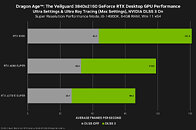
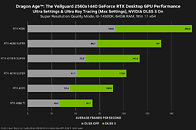
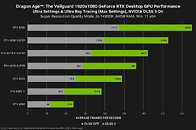
Additionally, GeForce gamers can activate NVIDIA Reflex in Dragon Age: The Veilguard. This game changing technology reduces system latency on GeForce graphics cards and laptops, so your actions occur quicker, giving you a competitive edge in multiplayer matches and making single-player titles more responsive and enjoyable. In Dragon Age: The Veilguard, enabling Reflex sees system latency reduced, further improving the PC experience for GeForce gamers.
Since its debut in September 2020, NVIDIA Reflex has reduced system latency in over 120 games, and over 90% of GeForce gamers have enabled Reflex. 9 of the top 10 competitive shooters feature Reflex support, along with critically acclaimed co-op and single-player games. In 2023 alone, GeForce gamers played over 10 billion hours of their favorite titles with increased responsiveness thanks to Reflex's innovative system latency reducing technology.
Take a look at Dragon Age: The Veilguard running on a GeForce RTX 40 Series PC with DLSS 3, Reflex and ray tracing below, and download and install our GeForce Game Ready Driver to ensure your experience is optimized from the instant you start playing.
For those that may not have the latest hardware, Dragon Age: The Veilguard will also be available to play at launch in the cloud on GeForce NOW. Ultimate members stream from GeForce RTX 4080-powered gaming rigs in the cloud and have access to the same cutting-edge technology as GeForce RTX 40 Series owners, including DLSS 3 and NVIDIA Reflex. To celebrate the launch of the game coming to GeForce NOW, we're giving those who purchase a 6-month Ultimate membership by October 30th Dragon Age: The Veilguard for free at launch.
Horizon Zero Dawn Remastered Out October 31st With DLSS 3, DLAA & Reflex
Experience the critically acclaimed Horizon Zero Dawn with stunning new visuals and upgraded features in Horizon Zero Dawn Remastered. In a far future where colossal machines roam the Earth, pockets of humanity survive in unique tribes among the lush, overgrown ruins of our long-lost civilization. Take up bow and spear as Aloy, a young machine hunter and outcast of her tribe, as she discovers her origins, the truth of this mysterious world, and her own destiny to save it from impending doom.
Horizon Zero Dawn is a multi-award-winning action role-playing game and this Remastered Edition, which also includes The Frozen Wilds expansion, brings to life the beloved wilds of Aloy's world in even higher fidelity with the power and potential of PC gaming. Rediscover the critically acclaimed game with enhanced graphics, new motion capture, and other improvements first seen in the sequel, Horizon Forbidden West Complete Edition.
GeForce RTX gamers playing Horizon Zero Dawn Remastered can accelerate performance with DLSS 3 with Frame Generation and Super Resolution.
On GeForce RTX 40 Series graphics cards, DLSS 3 increases frame rates at 4K, with settings maxed, by an average of 1.6X. GeForce RTX 4070 and GeForce RTX 4070 SUPER gamers can play at 100 FPS, GeForce RTX 4070 Ti SUPER owners can exceed 130 FPS, GeForce RTX 4080 SUPER users see frame rates surpass 160, and on the GeForce RTX 4090, the world's fastest consumer graphics card, GeForce RTX gamers receive the definitive experience, running at almost 200 FPS with Horizon Zero Dawn Remastered completely maxed out. At 2560x1440, DLSS 3's AI powered tech increases Horizon Zero Dawn Remastered's frame rates by an average of 1.5X, enabling every GeForce RTX 40 Series GPU to play with maxed out settings at over 80 FPS. And as a GPU's horsepower increases, so do the frame rates, quickly rocketing up to 260 FPS on the GeForce RTX 4090. At 1920x1080, Horizon Zero Dawn Remastered's frame rates almost exceed 300 FPS on the all-powerful GeForce RTX 4090 thanks to a 1.6X DLSS boost, and are locked at over 110 FPS on the GeForce RTX 4060, with every setting maxed, ensuring all GeForce RTX 40 Series gamers have a great experience when playing at 1920x1080, the most popular resolution.
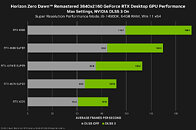
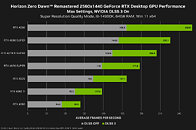
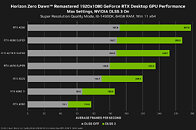
Additionally, GeForce gamers can make gameplay even more responsive with Reflex, and max out image quality with DLAA (which can be used in concert with Frame Generation). NVIDIA DLAA is an AI-based anti-aliasing mode that utilizes the same technology developed for DLSS. When enabling DLAA, it instead uses a native resolution image to maximize image quality, rather than boosting performance, for an even richer experience.
PC gamers with the requisite hardware can also enhance their experience with 21:9, 32:9, and 48:9 display support, and by playing on a wired DualSense controller, can increase immersion with adaptive trigger and haptic feedback functionality.
Ahead of Horizon Zero Dawn Remastered's October 31st release, we have launched our Horizon Zero Dawn Remastered GeForce Game Ready Driver, getting your system ready for the game, which is also available as a $10 upgrade for owners of the original Horizon Zero Dawn PC release. Download and install the new Game Ready Driver from the Drivers tab of NVIDIA app, GeForce Experience, or GeForce.com.
Red Dead Redemption Launching Today With DLSS 3 & Reflex
For the first time in its storied legacy, John Marston's beloved journey can be experienced on PC in stunning, new detail, with both Red Dead Redemption and its iconic zombie-horror companion story, Undead Nightmare, arriving on PC later today.
In collaboration with Double Eleven, Rockstar Games' new release adds PC-specific enhancements including adjustable draw distances, shadow quality settings, native 4K resolution rendering at up to 144 FPS / 144 Hz on compatible hardware, monitor support for both Ultrawide (21:9) and Super Ultrawide (32:9), HDR10 support, full keyboard and mouse functionality, and more.
And, of course, there's day-one support for NVIDIA DLSS 3 with Frame Generation and Super Resolution, and NVIDIA Reflex, ensuring GeForce RTX gamers receive the definitive PC experience the second they start playing, with accelerated frame rates and even more responsive gameplay.
Our newest GeForce Game Ready Driver also includes day-one support for Red Dead Redemption. Download and install from the Drivers tab of NVIDIA app, GeForce Experience, or GeForce.com.
Torque Drift 2 Update Adds DLSS 3 & Reflex
Torque Drift 2, a ray-traced racing game from Grease Monkey Games, now includes support for DLSS 3 with Frame Generation and Super Resolution, and NVIDIA Reflex. This immersive motorsport game set in an alternate reality modern-day Japan, builds upon the well-received Torque Drift 1 and years of community feedback to deliver a skill-based drifting game boasting an extensive garage of vehicles, open environments, player creation tools, and a multitude of single-player and multiplayer modes.
Using Torque Drift 2's newly-added DLSS 3 upgrade, GeForce RTX 40 Series gamers can multiply performance with every setting maxed and all ray tracing options enabled. And with NVIDIA Reflex, GeForce gamers can reduce PC latency, making racing and drifting more responsive, increasing your chance of success in the hardest races.
View at TechPowerUp Main Site | Source
Dragon Age: The Veilguard Launches October 31st With DLSS 3, Reflex & Ray Tracing
Rise as Rook, Dragon Age's newest hero. Be who you want to be and play how you want to play as you fight to stop the gods from blighting the world in Dragon Age: The Veilguard. But you can't do this alone - the odds are stacked against you. Lead a team of seven companions, each with their own rich story to discover and shape, and together you will become The Veilguard. When BioWare and Electronic Arts' Dragon Age: The Veilguard launches on October 31st, you'll be able to accelerate performance with DLSS 3, and enhance image quality and immersion with ray-traced reflections and ray-traced ambient occlusion.



On GeForce RTX 40 Series graphics cards, DLSS 3 with Frame Generation and Super Resolution multiplies performance at 4K by an average of 2.5X, with ray tracing and other settings completely maxed using the demanding Ultra preset. GeForce RTX 4070 Ti SUPER gamers can play at nearly 100 FPS, GeForce RTX 4080 SUPER owners see frame rates surpass 110 FPS, and on the GeForce RTX 4090, the world's fastest consumer graphics card, GeForce RTX gamers receive the definitive experience, running at 150 FPS with Dragon Age: The Veilguard completely maxed out. At 2560x1440, DLSS 3's AI powered tech increases Dragon Age: The Veilguard's frame rates by an average of 1.9X, enabling every GeForce RTX 40 Series GPU to play with maxed out settings at over 80 FPS. And as you go up the stack, performance rapidly increases, giving owners of the GeForce RTX 4070 and faster GPUs over 120 FPS, and up to 200 FPS on the GeForce RTX 4090. At 1920x1080, Dragon Age: The Veilguard's frame rates exceed 250 FPS on the all-powerful GeForce RTX 4090 thanks to a 1.9X DLSS boost. GeForce RTX 4060 owners can play at over 70 FPS with max settings and ray tracing, and performance gets even faster from there, maxing out the capabilities of many 1080p displays.



Additionally, GeForce gamers can activate NVIDIA Reflex in Dragon Age: The Veilguard. This game changing technology reduces system latency on GeForce graphics cards and laptops, so your actions occur quicker, giving you a competitive edge in multiplayer matches and making single-player titles more responsive and enjoyable. In Dragon Age: The Veilguard, enabling Reflex sees system latency reduced, further improving the PC experience for GeForce gamers.
Since its debut in September 2020, NVIDIA Reflex has reduced system latency in over 120 games, and over 90% of GeForce gamers have enabled Reflex. 9 of the top 10 competitive shooters feature Reflex support, along with critically acclaimed co-op and single-player games. In 2023 alone, GeForce gamers played over 10 billion hours of their favorite titles with increased responsiveness thanks to Reflex's innovative system latency reducing technology.
Take a look at Dragon Age: The Veilguard running on a GeForce RTX 40 Series PC with DLSS 3, Reflex and ray tracing below, and download and install our GeForce Game Ready Driver to ensure your experience is optimized from the instant you start playing.
For those that may not have the latest hardware, Dragon Age: The Veilguard will also be available to play at launch in the cloud on GeForce NOW. Ultimate members stream from GeForce RTX 4080-powered gaming rigs in the cloud and have access to the same cutting-edge technology as GeForce RTX 40 Series owners, including DLSS 3 and NVIDIA Reflex. To celebrate the launch of the game coming to GeForce NOW, we're giving those who purchase a 6-month Ultimate membership by October 30th Dragon Age: The Veilguard for free at launch.
Horizon Zero Dawn Remastered Out October 31st With DLSS 3, DLAA & Reflex
Experience the critically acclaimed Horizon Zero Dawn with stunning new visuals and upgraded features in Horizon Zero Dawn Remastered. In a far future where colossal machines roam the Earth, pockets of humanity survive in unique tribes among the lush, overgrown ruins of our long-lost civilization. Take up bow and spear as Aloy, a young machine hunter and outcast of her tribe, as she discovers her origins, the truth of this mysterious world, and her own destiny to save it from impending doom.
Horizon Zero Dawn is a multi-award-winning action role-playing game and this Remastered Edition, which also includes The Frozen Wilds expansion, brings to life the beloved wilds of Aloy's world in even higher fidelity with the power and potential of PC gaming. Rediscover the critically acclaimed game with enhanced graphics, new motion capture, and other improvements first seen in the sequel, Horizon Forbidden West Complete Edition.
GeForce RTX gamers playing Horizon Zero Dawn Remastered can accelerate performance with DLSS 3 with Frame Generation and Super Resolution.
On GeForce RTX 40 Series graphics cards, DLSS 3 increases frame rates at 4K, with settings maxed, by an average of 1.6X. GeForce RTX 4070 and GeForce RTX 4070 SUPER gamers can play at 100 FPS, GeForce RTX 4070 Ti SUPER owners can exceed 130 FPS, GeForce RTX 4080 SUPER users see frame rates surpass 160, and on the GeForce RTX 4090, the world's fastest consumer graphics card, GeForce RTX gamers receive the definitive experience, running at almost 200 FPS with Horizon Zero Dawn Remastered completely maxed out. At 2560x1440, DLSS 3's AI powered tech increases Horizon Zero Dawn Remastered's frame rates by an average of 1.5X, enabling every GeForce RTX 40 Series GPU to play with maxed out settings at over 80 FPS. And as a GPU's horsepower increases, so do the frame rates, quickly rocketing up to 260 FPS on the GeForce RTX 4090. At 1920x1080, Horizon Zero Dawn Remastered's frame rates almost exceed 300 FPS on the all-powerful GeForce RTX 4090 thanks to a 1.6X DLSS boost, and are locked at over 110 FPS on the GeForce RTX 4060, with every setting maxed, ensuring all GeForce RTX 40 Series gamers have a great experience when playing at 1920x1080, the most popular resolution.



Additionally, GeForce gamers can make gameplay even more responsive with Reflex, and max out image quality with DLAA (which can be used in concert with Frame Generation). NVIDIA DLAA is an AI-based anti-aliasing mode that utilizes the same technology developed for DLSS. When enabling DLAA, it instead uses a native resolution image to maximize image quality, rather than boosting performance, for an even richer experience.
PC gamers with the requisite hardware can also enhance their experience with 21:9, 32:9, and 48:9 display support, and by playing on a wired DualSense controller, can increase immersion with adaptive trigger and haptic feedback functionality.
Ahead of Horizon Zero Dawn Remastered's October 31st release, we have launched our Horizon Zero Dawn Remastered GeForce Game Ready Driver, getting your system ready for the game, which is also available as a $10 upgrade for owners of the original Horizon Zero Dawn PC release. Download and install the new Game Ready Driver from the Drivers tab of NVIDIA app, GeForce Experience, or GeForce.com.
Red Dead Redemption Launching Today With DLSS 3 & Reflex
For the first time in its storied legacy, John Marston's beloved journey can be experienced on PC in stunning, new detail, with both Red Dead Redemption and its iconic zombie-horror companion story, Undead Nightmare, arriving on PC later today.
In collaboration with Double Eleven, Rockstar Games' new release adds PC-specific enhancements including adjustable draw distances, shadow quality settings, native 4K resolution rendering at up to 144 FPS / 144 Hz on compatible hardware, monitor support for both Ultrawide (21:9) and Super Ultrawide (32:9), HDR10 support, full keyboard and mouse functionality, and more.
And, of course, there's day-one support for NVIDIA DLSS 3 with Frame Generation and Super Resolution, and NVIDIA Reflex, ensuring GeForce RTX gamers receive the definitive PC experience the second they start playing, with accelerated frame rates and even more responsive gameplay.
Our newest GeForce Game Ready Driver also includes day-one support for Red Dead Redemption. Download and install from the Drivers tab of NVIDIA app, GeForce Experience, or GeForce.com.
Torque Drift 2 Update Adds DLSS 3 & Reflex
Torque Drift 2, a ray-traced racing game from Grease Monkey Games, now includes support for DLSS 3 with Frame Generation and Super Resolution, and NVIDIA Reflex. This immersive motorsport game set in an alternate reality modern-day Japan, builds upon the well-received Torque Drift 1 and years of community feedback to deliver a skill-based drifting game boasting an extensive garage of vehicles, open environments, player creation tools, and a multitude of single-player and multiplayer modes.
Using Torque Drift 2's newly-added DLSS 3 upgrade, GeForce RTX 40 Series gamers can multiply performance with every setting maxed and all ray tracing options enabled. And with NVIDIA Reflex, GeForce gamers can reduce PC latency, making racing and drifting more responsive, increasing your chance of success in the hardest races.
View at TechPowerUp Main Site | Source




